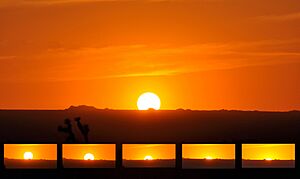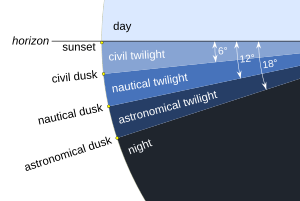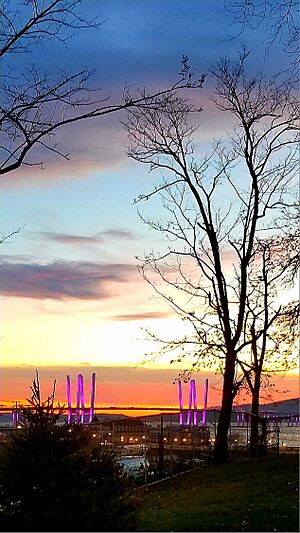Sunset facts for kids
A sunset is when the Sun seems to disappear below the horizon at the end of the day. This happens because the Earth is constantly spinning. From almost anywhere on Earth, you can see a sunset about once every 24 hours. However, near the poles, the Sun might not set for many days or even weeks.
During the equinox, the Sun sets exactly in the west. If you are in the Northern Hemisphere, the Sun sets towards the northwest in spring and summer. In autumn and winter, it sets towards the southwest. These directions are opposite if you are in the Southern Hemisphere.
In astronomy, sunset is when the very top edge of the Sun dips below the horizon. Because of how light bends in our atmosphere (called atmospheric refraction), the Sun actually appears a little higher than it truly is. This means the Sun has already gone below the horizon when we see it disappear.
Sunset is different from twilight. Twilight has three parts. First is civil twilight, which starts when the Sun sets and lasts until it's 6 degrees below the horizon. Then comes nautical twilight, when the Sun is between 6 and 12 degrees below the horizon. The third part is astronomical twilight, when the Sun is 12 to 18 degrees below the horizon. Dusk is the very end of astronomical twilight, just before it becomes completely night. Night begins when the Sun is 18 degrees below the horizon and no longer lights up the sky.
In places far north of the Arctic Circle or far south of the Antarctic Circle, there are days when the Sun does not fully set or rise. This is known as polar day or polar night. During these times, the Sun stays above or below the horizon for 24 hours or more.
Contents
How Sunsets Happen
The exact time of sunset changes throughout the year. It depends on where you are on Earth, including your latitude and longitude, how high you are, and your time zone. These daily changes are caused by the Earth's tilt, its daily spin, and its yearly journey around the Sun. The Moon's orbit also plays a small role.
During winter and spring, the days get longer, and sunsets happen later each day. This continues until the day of the latest sunset, which occurs a little after the summer solstice. In the Northern Hemisphere, the latest sunset is usually in late June or early July. This date is not exactly on the summer solstice (June 21) because the Earth moves a bit slower around the Sun in early July.
Similarly, the earliest sunset does not happen on the winter solstice. It occurs about two weeks earlier. In the Northern Hemisphere, this is in early December or late November. This is because the Earth moves faster around the Sun in early January.
The same patterns happen in the Southern Hemisphere, but the dates are swapped. The earliest sunsets are before June 21 (winter), and the latest sunsets are after December 21 (summer). For a few weeks around both solstices, both sunrise and sunset happen a little later each day. Even at the equator, sunrise and sunset times shift slightly throughout the year. These changes are shown on a special diagram called an analemma.
Ignoring how the atmosphere bends light and the Sun's actual size, the Sun always sets in the northwest from March to September. From September to March, it sets in the southwest. On the equinoxes, the Sun sets almost exactly due west for everyone on Earth.
Because we measure sunrise from the first glimpse of the Sun and sunset from its last glimpse, daytime is slightly longer than nighttime. This is also due to light bending in the atmosphere. The Sun is still visible even after it has geometrically gone below the horizon. This bending of light also makes the Sun look a bit squashed when it is very low in the sky. Light from the bottom edge bends more, making the bottom appear higher. This makes the Sun look wider than it is tall. The Sun also appears larger when it's on the horizon, which is an optical illusion, much like the moon illusion.
Places inside the Arctic Circle and Antarctic Circle have periods of polar day or polar night. During these times, the Sun does not rise or set for 24 hours or more. This happens because of the Earth’s tilt, which causes continuous sunlight or darkness at certain times of the year.
How Latitude Affects Sunsets
Latitude determines the angle at which the sun's path cuts across the sky relative to your horizon.
At the equator (0° Latitude) the sun's path is almost perfectly vertical, rising and setting very quickly. This means twilight is very short—the sun plunges almost straight down below the horizon, resulting in a brief but often intensely colorful sunset.
At mid-latitudes (e.g., 40°N or 40°S) the sun's path is diagonal relative to the horizon. It takes longer for the sun to "sink" below the horizon, leading to a longer, more drawn-out sunset and a longer period of twilight (both civil and nautical).
At the poles (90° latitude) during the summer, the sun doesn't set at all (Midnight Sun). As autumn approaches, the sun sets in an extremely slow, horizontal spiral, taking days or even weeks to finally disappear below the horizon, leading to a very long twilight period.
The steeper angle at low latitudes means sunlight has to pass through less of the thickest part of the atmosphere at sunset, which can lead to purer, more intense colors for a shorter time.
The shallower angle at high latitudes means sunlight travels through a much longer, thicker slice of the atmosphere. This scatters the shorter blue and green wavelengths more completely, often leaving behind the deeper reds and oranges for a longer, sometimes more pastel-colored sunset.
Civil Twilight (when you can still do things outside without artificial light) is shortest at the equator (about 20-25 minutes) and can last for hours at high latitudes. In places like northern Scotland or Alaska, "night" never truly gets dark in the summer; it remains in a state of twilight.
How Longitude Affects Sunsets
Longitude is much simpler. It determines your position within a time zone.
The Earth is divided into 24 time zones, each roughly 15 degrees of longitude wide.
The sun appears to move from east to west at a rate of 15 degrees per hour.
Therefore, for every 1 degree of longitude you move west, the sunset (and sunrise) will occur 4 minutes later.
Example in the United States:
New York City (~74°W) and Indianapolis (~86°W) are in the same Eastern Time Zone.
However, Indianapolis is 12 degrees of longitude west of New York.
12 degrees × 4 minutes/degree = 48 minutes.
So, on the same day, the sun will set in Indianapolis about 48 minutes later than it does in New York, even though their clocks show the same time.
This is why the western edge of a time zone often has later sunsets than the eastern edge.
Where the Sun Sets
The exact spot where the Sun sets on the horizon changes throughout the year. It depends on your location (latitude) and the date. On the equinoxes, the Sun sets almost exactly due west.
During spring and summer, the Sun sets more towards the northwest if you are in the Northern Hemisphere. During autumn and winter, it sets more towards the southwest. These directions are reversed for people in the Southern Hemisphere. Scientists use special calculations to figure out the precise direction of sunset for any given day and location.
Why Sunsets Have Amazing Colors
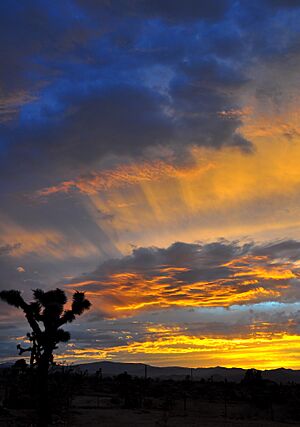
When white sunlight travels through the Earth's atmosphere, some of its colors get scattered away. This scattering happens because of tiny air molecules and other particles in the air.
Shorter wavelengths of light, like blue and green, scatter more easily. This is called Rayleigh scattering. When the Sun is low in the sky during sunrise or sunset, its light has to travel through a lot more atmosphere. Most of the blue and green light gets scattered away before it reaches our eyes. This leaves behind the longer wavelengths, which are the orange and red colors we see. These red and orange colors can then be scattered by clouds or larger particles, making the horizon glow with vibrant hues.
Sunsets often look more colorful than sunrises. This is because the air in the evening usually has more dust and particles than the air in the morning. Sometimes, just before or after the Sun sets, you might even see a rare green flash.
Volcanic eruptions can also affect sunset colors. Ash trapped low in the atmosphere can make sunsets look dull. But if volcanic dust is shot high into the stratosphere, it can create beautiful colors after sunset, called afterglows. Famous eruptions, like Mount Pinatubo in 1991 and Krakatoa in 1883, produced amazing afterglows around the world. These high-altitude clouds reflect the reddened sunlight back down to Earth even after the Sun has set.
You can also see many different colors in the eastern sky after the Sun has set. These colors can be quite varied and beautiful, depending on the weather and types of clouds.
Words for East and West
In many languages, the names for points of the compass come from words related to sunrise and sunset. For example, the English words "orient" (east) and "occident" (west) come from Latin words meaning "sunrise" and "sunset."
In Polish, the word for east, wschód, means "up-move," because the Sun moves up from behind the horizon. The word for west, zachód, means "behind-move," as the Sun goes behind the horizon. In Russian, the word for west, запад (zapad), means "behind-fall," referring to the Sun falling behind the horizon. In Hebrew, the word for east, 'מזרח', comes from the word for rising, and the word for west, 'מערב', comes from the word for setting.
Understanding Our Solar System
In the 1500s, the astronomer Nicolaus Copernicus was the first to show the world a detailed mathematical model. This model explained that the Earth actually moves around the Sun, and the Sun stays still. This was a big change from the old idea that the Sun moved around the Earth.
Sunsets on Other Planets
Sunsets on other planets look different from those on Earth. This is because planets are different distances from the Sun, and they have different atmospheres, or sometimes no atmosphere at all.
Mars
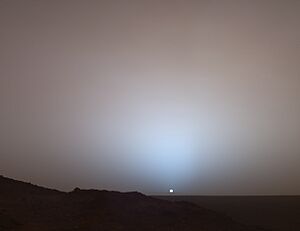
On Mars, the setting Sun looks about two-thirds the size it does from Earth. This is because Mars is farther away from the Sun. Martian sunsets often have blue colors. Some Martian sunsets can also last much longer and appear redder than typical Earth sunsets.
The colors of a Martian sunset are different from Earth's. Mars has a very thin atmosphere with almost no oxygen or nitrogen. Instead, its air is full of red dust, blown by strong winds. This dust scatters light differently than Earth's atmosphere. This is why Martian sunsets often have more blue colors. Scientists have also found that Martian dust high in the atmosphere can reflect sunlight for up to two hours after the Sun has set, creating a soft glow across the planet's surface.
Sunset's Special Meaning
Sunsets are a natural event that many people find very beautiful. They are a popular subject for artists and photography.
In some calendars, like the Hebrew calendar, the Islamic calendar, and the Bahá'í calendar, a new day officially begins at sunset.
See also
 In Spanish: Ocaso para niños
In Spanish: Ocaso para niños
- Dawn
- Diffuse sky radiation
- Earth's shadow, visible at sunset
- Golden hour (photography)
- Heliacal setting
- Sundown town


